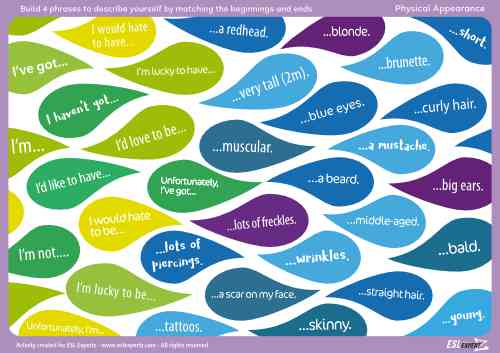
Talk About Your Physical Appearance: Begendings
Help A1 and A2 students practice describing themselves with this fun, online-friendly, and printable Describe Yourself in English activity. Students match the beginnings and endings of phrases to create four personalized statements about their physical appearance. Perfect for building confidence in speaking and using basic vocabulary.
Describe Yourself in English – A Fun Speaking and Vocabulary Activity for A1 and A2 Students
This Describe Yourself in English activity is a fantastic online-friendly and printable resource for A1 and A2 ESL students to practice and master describing their physical appearance. Designed to build confidence in speaking and using basic vocabulary, students match the beginnings and endings of phrases to create personalized statements about themselves.
The activity helps students learn to describe themselves in English by combining sentence starters like “I am…”, “I’m not…”, “I haven’t got…”, and “Unfortunately, I’ve got…” with endings like “…blue eyes,” “…straight hair,” “…skinny,” and “…muscular,” to form complete statements. Students will work individually, in pairs, or small groups, ensuring they actively practice speaking while learning key physical appearance vocabulary.
How it works:
-
Matching Phrases: Students match phrase beginnings with endings, creating four statements that describe their physical appearance.
-
Personalization: By constructing these statements, students practice basic adjectives and expressions commonly used to talk about physical features.
-
Speaking Practice: Once the statements are complete, students will present their descriptions to the class or their partner, reinforcing their speaking and listening skills.
Fun variants:
1. Role-Play Variant
-
How it works: After students create their own descriptions, ask them to take on a different role or identity (e.g., a famous person, a fictional character, or classmate) and describe that character’s physical appearance instead. This encourages creativity and adds an element of fun.
-
Objective: Practice using the same vocabulary to describe different people, while also making use of imagination.
2. Guess Who Variant
-
How it works: In small groups, choose one person in the group to descirbe using the matched phrases but without revealing their identity. The other students then have to guess who they are describing based on the physical features mentioned.
-
Objective: This encourages listening comprehension and reinforces vocabulary as students must listen carefully and analyze the descriptions.
3. Memory Challenge Variant
-
How it works: Students create a self-description and then try to remember and recite other students’ descriptions. This variant can be turned into a game by giving points for each correctly recalled detail.
-
Objective: Helps improve memory retention of physical appearance vocabulary and boosts speaking fluency.
4. Find Someone Who Variant
-
How it works: Create a list of physical features (e.g., “has straight hair,” “is muscular,” “has blue eyes”). Students have to walk around the classroom and find someone whose physical appearance matches the descriptions on the list. Once they find someone, they can form a sentence like, “Maria has straight hair.”
-
Objective: This encourages students to interact with each other and practice describing their peers’ physical appearance.
5. Group Description Variant
-
How it works: Students work in groups, and each group has to create a collective description of a person. The group can decide on the best match for the phrases, and then present their description to the class. You can take this further by having different groups describe famous figures or classmates.
-
Objective: Encourages collaboration and speaking in groups while reinforcing vocabulary and grammatical structures.
6. Adjective Race Variant
-
How it works: Instead of just matching beginnings and endings, challenge students to come up with as many adjectives as they can to describe themselves, using those adjectives in full sentences (e.g., “I am tall,” “I have short hair,” “I’m not muscular.”). The first student or team to come up with a set number of unique adjectives wins.
-
Objective: Boosts vocabulary recall and helps students use a broader range of adjectives to describe physical appearance.
7. True or False Variant
-
How it works: After students write their self-descriptions, they exchange them with a partner. The partner must listen to the description and then say if it’s true or false. If false, the partner can guess the correct description.
-
Objective: Reinforces listening comprehension and understanding of the language used to describe physical appearance.
8. Mystery Person Variant
-
How it works: A student gives a description of someone’s physical appearance (could be a famous person or a character) without revealing their identity. Other students have to guess who the person is based on the description.
-
Objective: Increases listening comprehension and helps students practice detailed descriptions of physical features.
This engaging activity is ideal for building fluency in describing physical characteristics, helping students gain confidence when talking about themselves in English.
Reviews
It takes a team of 13 to create and produce this material. In order for that to continue, please think about purchasing your own subscription to ESL Expertz and encourage your colleagues to do the same. We appreciate your confidence and support!
There are no reviews yet.